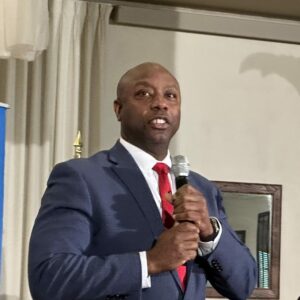Sen. Tim Scott (R-S.C.) agrees America’s entitlement spending is driving the U.S. economy toward a debt crisis. He decries the record $33 trillion national debt, more than $5 trillion added since President Joe Biden took office. In fact, the debt has grown by $1 trillion since June 15 of this year alone.
But rather than talking about reforming entitlements — raising the retirement age or lifting the cap on payroll taxes — the South Carolina Republican told a New Hampshire audience Wednesday morning the solution is economic growth.
Lots of it.
“For us to actually have the resources necessary to meet our obligations, the first thing we can do is grow our economy,” Scott said at the Politics and Eggs breakfast hosted by the New England Council and New Hampshire Institute of Politics. “If we grew our economy at five or six [percent] using my ‘Build, Not Borrow’ plan — and ‘Made in America’ as well — to create those 10 million new jobs, we could actually have trillions of dollars of economic activity in our economy to result in billions of dollars of new revenues to the Treasury.
“If we don’t grow our economy close to 5 percent, we will not have the revenue generation to meet the needs that we have on our permanent spending,” Scott added.
The idea is easy to understand. But is it possible to achieve?
In the second quarter of 2023, the Gross Domestic Product (GDP) grew 2.6 percent yearly, up from 1.8 percent in Q1. The average annual growth rate in the U.S. from 1948 until 2023 was 3.12 percent, according to data from the World Bank. In 2019, before the COVID-19 lockdowns forced the U.S. into a recession, GDP growth was just 2.29 percent.
In an interview after his speech, NHJournal asked Scott if a five percent GDP growth plan beginning in 2025 was realistic.
“Well, we haven’t created 10 million jobs in the next few years in a long time. We had a robust economy under former president [Trump], and I wrote the tax bill, and that’s why I’m really proud of it,” Scott said. “We created seven million new jobs in the most inclusive economy in… the last 50 years.
“So, if you could do that on steroids, if we were able to reduce the corporate tax from 35 percent to 31 percent and reshore about $1.72 trillion to $ 2 trillion, that also goes a long way toward building that [5 percent] economic activity. Because what we need is the economic activity in the private sector that then correlates to more revenue to the Treasury.”
But economists are doubtful.
“A five percent rate of growth for a mature economy like America’s just isn’t realistic,” said Brian Marks, a senior lecturer in the Department of Economics at the University of New Haven.
“Sen. Scott brags about his tax cut plan, but look at growth in 2019, before the pandemic. It wasn’t five percent. It wasn’t even three percent. The historic average is around three percent. If your plan is to nearly double that and do it over the long run, you need a new plan.”
Bruce Elmslie, Chair of the Economics Department at UNH, isn’t any more optimistic.
“General economic policies such as ‘Made in America’ surely will not achieve this [rate of growth],” Elmslie told NHJournal. “In the longer term, all economic growth is technological growth.”
According to Elmslie, achieving such a high GDP growth rate isn’t about politics; it’s about technology.
“The rate of growth of any country is determined by its ability to create new technology or to borrow from existing technologies from other countries,” Elmslie said. And he sees artificial intelligence (AI) as a potential game-changer, not any government action. “If AI succeeds in increasing labor productivity rapidly over the next few decades, as many are predicting, such a real rate of growth over this period of rapid technological change could make such an aspiration real.”
Paul Steidler with the Lexington Institute, a conservative public policy think tank in Arlington, Va., said Scott is making a mistake by not looking for a Social Security fix as part of addressing the debt and deficit problem.
“It is going to be quite difficult, if not impossible, to have consistent real GDP growth of 5 percent or more, year after year. A better way to help hard-working Americans is to permit them to invest some of the large amount of Social Security retirement taxes they pay into private accounts,” Steidler said. “This way, people can decide how at least a portion of their Social Security money is invested and potentially get higher returns, that is more income.”



